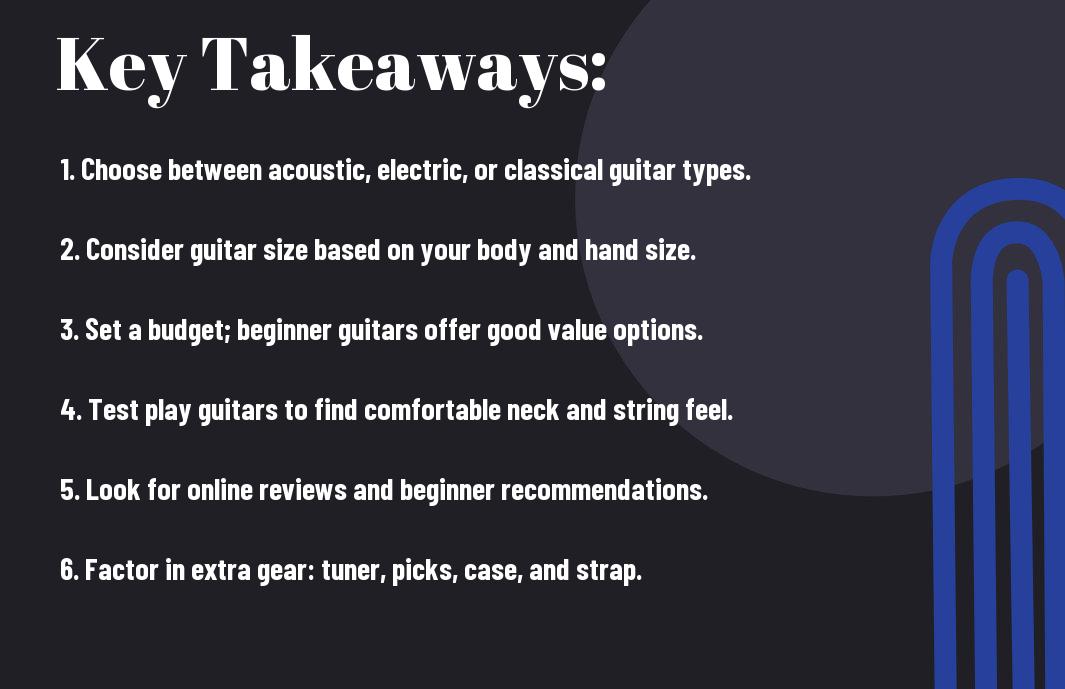Beginning your journey with the guitar can be overwhelming, but it can also be an exciting adventure. As I explored my options, I learned that selecting the right guitar involves understanding your playing style, budget, and comfort. You’ll want to avoid common pitfalls, such as choosing an instrument that doesn’t suit your needs or overspending on features you may not use. I’ll guide you through the crucial factors to consider, so you can make an informed decision and find the perfect guitar that inspires you to play.

Decoding Your Musical Aspirations
Understanding what you hope to achieve with guitar playing can guide your decisions for selecting the right instrument. Whether you dream of strumming along to your favorite songs, performing in front of an audience, or composing your own music, it’s imperative to align your goals with the type of guitar you choose. Making these aspirations clear not only fuels your motivation but also helps narrow down your options significantly.
Identifying Your Preferred Genre
Your choice of genre will heavily influence not just the style of music you want to play, but also the type of guitar that will best complement your aspirations. For instance, if you’re drawn to rock or metal, an electric guitar may be more suitable, while folk enthusiasts often lean towards acoustics. Spend time listening to various genres to find the sound that resonates with you the most.
Evaluating Your Commitment Level
The commitment level you’re willing to invest in learning the guitar is another key factor in your selection. Are you in this for a casual hobby, or do you see yourself practicing daily to master difficult pieces? If you’re planning to dedicate several hours a week, investing in a higher-quality instrument is worth considering, as it can enhance both your practice experience and long-term growth. Those testing the waters might want to start with a more affordable option.
Assessing your commitment can often reveal whether you’re ready for a long-term investment or just exploring a fleeting passion. For example, I’ve seen friends buy expensive guitars only to abandon their hobbies months later due to a lack of time or interest. Conversely, those who committed a smaller amount but dedicated themselves to practice often found more enjoyable experiences, leading to improved skills and sustained interest in music. Establishing a realistic practice schedule and sticking to it can also serve as a significant motivator; choose a guitar that suits your level of dedication and be honest with yourself about how much time you can realistically devote.
Navigating the Guitar Market
Shopping for your first guitar can feel like wandering through a maze of options, features, and marketing jargon. The vast market includes everything from budget options to high-end models, so narrowing down your choices can be daunting. I found researching online reviews necessary, and visiting local music stores to try out different guitars made all the difference. Pay close attention to the specifications, feel, and sound quality while comparing options. This way, you can confidently choose a guitar that resonates with you, both literally and figuratively.
Budgeting for Your First Purchase
Establishing a budget before submerging into the guitar market can save you a heap of stress. Initially, I aimed for a range of $200 to $500, which allowed me to explore both decent beginner and intermediate guitars. This price range typically offers solid options without breaking the bank. Keep in mind that accessories like picks, straps, and cases will add to your total, so factor those into your overall budget.
Understanding Different Guitar Brands and Models
Guitar brands and models vary widely in sound, build quality, and playability, making it vital to understand their characteristics before buying. Popular brands like Fender, Gibson, and Yamaha each have their unique appeals. For instance, Fender is known for its electric models and bright tones, while Gibson guitars often offer a richer, warmer sound. Exploring different brands can help you identify what fits your playing style best.
When I began my guitar hunt, learning about brands like Epiphone and Ibanez opened up my options. Epiphone models are fantastic for those wanting a quality guitar at a more affordable price without compromising too much on sound. On the other hand, Ibanez guitars are great for rock and metal genres due to their sleek designs and fast necks tailored for technical playing. Even within a brand, each model can offer something distinctive—like the choice between acoustic and electric or different body styles. Getting a feel for these specifics not only informs your purchase but also enriches your learning experience as you grow as a guitarist.
The Anatomy of a Guitar: What to Look For
Understanding a guitar’s anatomy is fundamental to making an informed decision. Whether you’re looking at an electric or acoustic model, each component plays a vital role in sound production and playability. I recommend checking features such as the body type, neck profile, and fretboard materials, as these will significantly influence your overall experience and satisfaction with the instrument.
Key Features: Body Type and Neck Considerations
Choosing the right body type and neck for your guitar can impact every aspect of your playing. You may favor a solid, semi-hollow, or hollow body depending on your desired tone and play style. The neck is equally important; consider its shape (C, D, or V), scale length (different lengths affect string tension), and wood type (maple, mahogany, etc.) for a more comfortable playability. After evaluating these elements, you’ll be closer to finding the right guitar for you.
Essential Hardware: Pickups, Tuners, and More
Exploring the hardware of your potential guitar can significantly influence your choice as well. Pickups, tuners, and bridge types contribute to sound quality and tuning stability. I often look for a guitar that offers versatile pickup options, ensuring I can cover various musical styles. Additionally, reliable tuning machines allow for easy adjustments, while the type of bridge can affect the sustain and overall tone. Other aspects like the nut material also play a part in the guitar’s overall performance.
The pickups, which are the heart of electric guitars, come in various configurations, including single-coil and humbucker types. Single-coils provide a bright, articulate sound, while humbuckers offer a thicker tone and reduced noise. I recommend testing both to see which fits your style better. Quality tuners are equally important; they keep your instrument in tune during play, which is vital for practice and performance. A stable bridge, whether fixed or tremolo, can further enhance your tuning stability and tonal output, making it an important factor in your selection process.
Trying Before You Buy: The Essential Hands-On Experience
In-person experience provides invaluable insights that can’t be captured in online descriptions. When choosing your first guitar, picking one up and playing it yourself can make all the difference. This tactile experience helps you understand the instrument’s weight, neck feel, and overall playability. I highly recommend visiting a store to see how each guitar resonates with you, allowing you to make an informed choice that matches your unique style and preferences.
Visiting Local Music Shops: What to Expect
Walking into a local music shop can feel both exciting and intimidating. Expect to see a variety of guitars from different brands, each with unique features. Many shops encourage you to test the instruments, so don’t hesitate to ask to play them. Knowledgeable staff can offer insights and help guide you, making the experience more enlightening. Take your time, and consider bringing a friend for opinions and support.
The Role of Online Reviews and Expert Opinions
Diving into online reviews can complement your hands-on experience. Websites and forums are filled with testimonials from fellow players, offering a wealth of insights about specific models and brands. Be sure to look at both expert reviews and user opinions, as they can highlight aspects like durability, sound quality, and versatility that might not be obvious during a brief visit to the store.
Online reviews present a treasure trove of information, helping you weigh the pros and cons of various guitars. Many users detail their experiences with specific models, providing feedback on playability, setup ease, and sound. Some even discuss longevity and how well the instrument performs over time. Expert opinions often cover specifications like wood types and construction techniques, which can aid your decision-making process. Just make sure the sources you consult are reputable; because reviews are subjective, reading multiple perspectives can give you a more rounded view. This approach ensures that you’re backed by both community insights and professional knowledge, enhancing your overall buying confidence.
Essential Accessories for New Guitarists
Equipping yourself with the right accessories can elevate your playing experience significantly. While choosing your first guitar is vital, Choosing Your Weapon (My advice for buying your first … wouldn’t be complete without imperative gear like picks, tuners, and cases. Your journey will be much smoother with these items at your side.
Must-Have Gear: Picks, Tuners, and Cases
Picks are your best friends; they come in various shapes and thicknesses to suit your playing style. A reliable tuner is indispensable, ensuring your guitar sounds its best before every practice session. Additionally, a sturdy case protects your investment—especially during transportation. Investing in these imperatives forms the backbone of your new musical venture.
Enhancing Your Musical Journey: Lessons and Resources
Your development as a guitarist doesn’t stop at purchasing the instrument and imperatives. I highly recommend seeking lessons, either online or in-person, to establish a solid foundation. There are numerous platforms available today, offering tailored lessons that can help you learn at your own pace. Also, online forums and resources expand your understanding of techniques and genres.
Consider taking structured lessons from professional instructors or using popular apps designed for beginners—some even offer gamified experiences to make learning enjoyable. Engaging with fellow guitarists through online communities can provide support and inspiration. You’ll find a wealth of tutorials on YouTube, sheets available on sites like Ultimate Guitar, and forums where you can ask questions and receive feedback. Each resource plays a vital role in shaping your skills and confidence, allowing you to explore diverse musical styles and techniques with ease.
Conclusion
Summing up, choosing your first guitar is an exciting journey that requires careful thought about your musical goals, budget, and personal preferences. I encourage you to try out different models in stores to find what feels right in your hands. Whether it’s an acoustic or electric guitar, prioritize comfort and playability. By taking the time to make an informed decision, you’ll set a solid foundation for your musical growth. Happy strumming!




